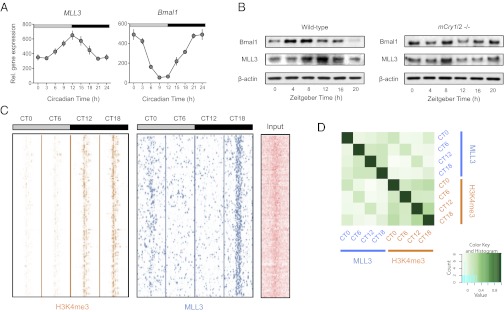Fig. 2.

MLL3 is a circadian factor that binds to the genome rhythmically. (A) Expression of MLL3 (and the control gene, Bmal1) in mouse liver over the circadian cycle. Data are means ± SEM for three biological replicate liver samples per time point. (B) Abundance of MLL3 (and Bmal1) protein in wild-type and cryptochrome-deficient (mCry1/2−/−) mouse livers sampled over the day and night. Immunoblots representative of at least three independent time courses are shown. β-Actin blots are shown as gel loading controls. (C) Heat maps showing H3K4me3- and MLL3-binding signal at hundreds of promoter regions, from –5 kb to +5 kb surrounding the center of each binding site. Each line represents an H3K4me3 site and MLL3-binding region. CT, circadian time (animals maintained in constant darkness, with subjective dawn represented by CT0, and dusk represented by CT12). The input (nonenriched) DNA signal at the same locus is shown for comparison. (D) Heat map representing MLL3-binding events compared with those of H3K4me3. For each of the differentially bound sites, the reads per kilobase per million mapped reads (RPKM)-fold (RPKM of ChIP divided by RPKM of control) was calculated for each sample, and a Pearson correlation value for each sample pair computed. The heat map shows the correlation scores.
